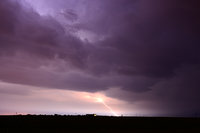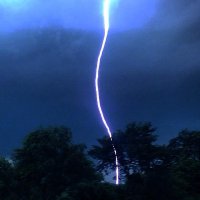Ben_Jacobi
EF1
I'm not really sure if I should be posting this here, so forgive me if that is incorrect. The other day 4/22 a line of thunderstorms came through our area. I was excited since I couldn't chase the storms in the panhandle and was hoping to catch some lightning photography from the line of storms. I got my wish and spent an hour photographing the lightning from my apartment balcony. Some of the lightning was really photogenic and some of it left me a little curious. There were several times when I saw a quick bright flash above my head and see a strike off to the west by a few miles. It was a very short, but intense duration and when I looked at the photos the lightning was a very smooth bolt with no branching. Were these positive strikes I was seeing? I don't really know how to explain it, so I included a photo. I know its not my camera settings because there were other strikes in between with lots of branching. Any idea what might be causing the smooth bolt? Thanks.
-Ben
-Ben




